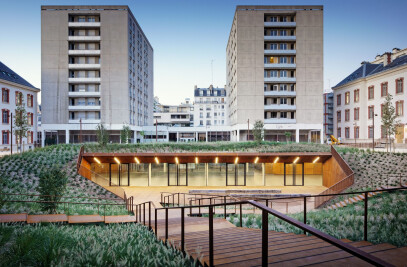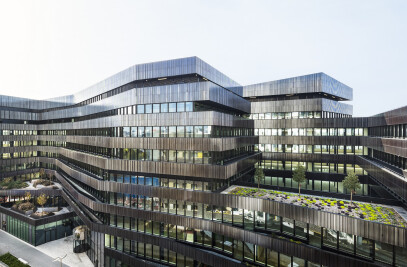CONTEXT The Moulin Junior High School is located in the southern area of Lille, in a neighborhood that has undergone major transformations in recent decades. Mainly occupied by a population of workers, this neighborhood possesses an urban fabric that is still largely one of brick buildings, factories and buildings related to freight whose renovation has spurred a renewal of the entire neighborhood (as illustrated in reconversion of the Saint-Sauveur train station for example). The site of the junior high school, which is also equipped with multiple programs, stands on a lot next to which the elevated train passes. Located at the gateway to the neighborhood, it must also meet the requirements of several very different urban situations: a broad boulevard, a narrow street and an elevated train.
On the main boulevard d’Alsace, the facility presents a highly transparent ground floor; which offers students a large open view to the outside and a view with great depth of field into the heart of the lot for the passerby on foot. This glass façade guides the neighbor, runs along the orchestra hall, which is in an angle overlooking the boulevard, then past the table tennis room with its hollowed out depth of 5 meters and its two all glass façades. Complete transparency here offers an environment for recess/recreation area, providing a visual link between the public space and the inner world of the junior high school.
As seen from the elevated metro, the upper floors of the complex are treated like a landscape, playing with the topography of its masses. Les elements of the program become clearly identifiable: the junior high school, the fitness room of the boarding school, the orchestra hall. This geographic situation is bound together with a flexible skin, in pre-patinated zinc, which follows the forms of each volume while creating an emblematic urban signal, for both the facility and the neighborhood.
A ring of vegetation crowns the entire roof with a meadow and ensures great visual comfort for users as well as neighbors. This rooftop landscape guides and underscores the movements of the roof, which extends in three directions. Here, zinc is used for its multipurpose function and its texture: cladding walls, roofs and awnings, it is adjusted to all the spaces and marks off the volumes with folds that underscore diagonals, thereby linking one program with the next. The irregular rhythm of standing seams in an effect of graphic contrasts underscores all the softness of the reflections from the zinc to the warm brown tones, and reveals the delightful quality of this material.
Equipped with this sensitive skin, the building is organized in the form of a continuous ribbon, arranged around the central courtyard. All the programs are connected to this area on the ground floor. The upper floors enjoy a direct view onto the planted terraces, and especially the rooms in the R+1 class, which are directly connected. The “skyline” offered by the irregularity of the roof lines is quite variable and offers several views opening onto neighboring buildings and onto the public space. Thus, wherever one is standing in this establishment, it is easy to find one’s bearings, inside the junior high school but also outside in its specific relationship with the neighborhood.
The theme of the line present on all the façades through the seamed zinc roof extends outward to from a sunbreak in front of vertical circulations and the orchestra hall. This graphic quality, like a hatch mark, turns inward toward the facility and serves as a line unifying the different programs.
A motif printed on the glazed concrete surfaces of the corridors of the college plays the role of “epigram-graffiti.” This motif is also found on the walls separating the cafeteria area. Its welded black metal screens visually delimit the space and maintain the full depth of field of the entire volume. The orchestra hall, arranged in movable seating stands, is equipped with overhead light fixtures composed of thermo-lacquered black metal strips whose lines project their motifs throughout the concert hall. Facing the street, like a scratch, the glass façade is marked with yellow adhesive strips, which are echoed by the meatal graphic quality of the entrance to the junior high school.

































